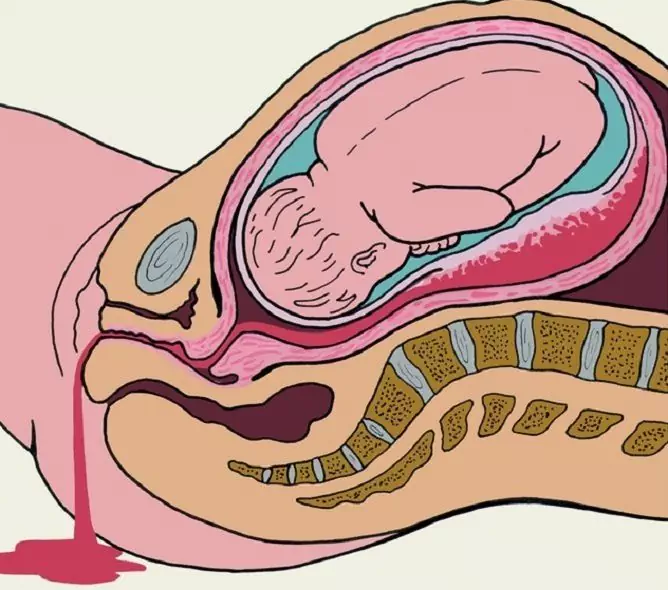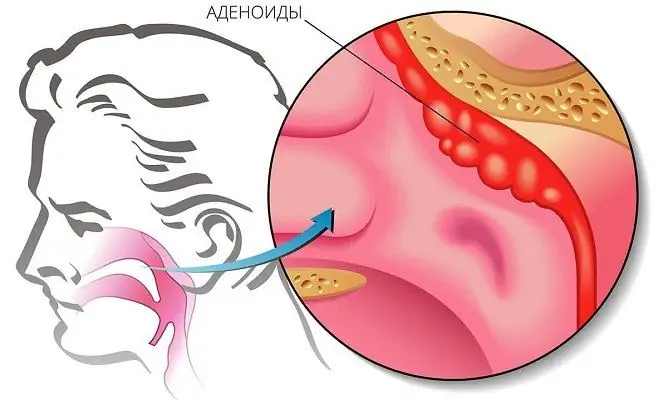- Author Rachel Wainwright [email protected].
- Public 2023-12-15 07:39.
- Last modified 2025-11-02 20:14.
Pseudomembranous colitis
The content of the article:
- Causes and risk factors
- Forms of the disease
- Symptoms of pseudomembranous colitis
- Features of the course of the disease in children
- Diagnostics
- Treatment of pseudomembranous colitis
- Possible complications and consequences
- Forecast
- Prevention
Pseudomembranous colitis is an inflammatory process in the large intestine that develops against the background of the use of antibacterial drugs or some other drugs. The anaerobic gram-positive microorganism Clostridium difficile acts as an infectious agent in pseudomembranous colitis. Some antibacterial drugs, suppressing the normal intestinal microflora, contribute to the creation of favorable conditions for the reproduction of Clostridium difficile, as a result of which the pathogenic properties of this microorganism are manifested.

The cause of pseudomembranous colitis is the multiplication in the intestine of Clostridium difficile
The patient develops a specific dysbiosis, the result of which is inflammation of the mucous membrane of the large intestine with the formation of characteristic fibrinous films (pseudomembranes) on it, due to which the disease got its name. The length of the lesion of the intestinal mucosa is variable, most often the rectum, sigmoid and descending intestines are involved in the pathological process, in severe cases the entire large intestine can be affected.
Causes and risk factors
The reason for the development of pseudomembranous colitis is a violation of the normal microflora of the large intestine and excessive reproduction of Clostridium difficile in the intestine. The cause of intestinal dysbiosis, against the background of which pseudomembranous colitis occurs, is usually the use of antibacterial drugs, in more rare cases, the development of the pathological process is due to the use of other drugs (laxatives, immunosuppressants, cytostatics). As a rule, the disease occurs against the background of prolonged oral administration of drugs, but sometimes pseudomembranous colitis can occur after a single dose of the drug.
Clostridium difficile is a type of anaerobic gram-positive microorganisms of the genus Clostridia, the detection rate of which in healthy people is 0-3%. In the case of excessive reproduction of Clostridium difficile, toxic substances are released that have a toxic effect on the intestinal mucosa, which causes the development of pseudomembranous colitis. Continuation of drug therapy in this situation contributes to the aggravation of intestinal damage. There is an increased secretion of fluid by the intestinal wall, which enters the intestinal lumen. In parallel, the absorption of toxic waste products of clostridia is observed, which causes signs of intoxication of the body. With the progression of the pathological process, the patient develops dehydration and concomitant electrolyte imbalance.

Most often, pseudomembranous colitis occurs after prolonged use of antibiotics
The disease often appears in patients who are being treated in a hospital. Staying in the same ward with patients with pseudomembranous colitis increases the risk of developing the disease.
Other risk factors are:
- elderly age;
- pathology of the gastrointestinal tract;
- somatic diseases in the stage of decompensation;
- malignant neoplasms;
- renal failure;
- immunodeficiency states;
- extensive surgical interventions;
- conditions requiring intensive care (life-threatening conditions).
Forms of the disease
Depending on the severity, pseudomembranous colitis can be mild, moderate, or severe.
May have an acute, subacute and recurrent course.

Forms of pseudomembranous colitis
Symptoms of pseudomembranous colitis
The symptoms of pseudomembranous colitis depend on the severity of the disease. Mild pseudomembranous colitis is characterized by cramping abdominal pain and persistent diarrhea. Abdominal pain worse before defecation, false urge to defecate is noted. Stool copious, watery, mixed with mucus. The abdomen is moderately distended, painfulness along the colon is observed on palpation. There are signs of general intoxication of the body in the form of headache, weakness, sometimes fever, nausea, and vomiting. After discontinuation of the drug that provoked the development of the pathological process, the symptoms of pseudomembranous colitis disappear.
Moderate symptoms persist for one or more weeks after the causative drug is discontinued. In this case, prolonged diarrhea is observed, the feces take the form of rice water with a yellowish or greenish color. The feces contain impurities of blood and mucus. The loss of a significant amount of fluid during bowel movements causes dehydration, which is manifested by increasing weakness, a decrease in blood pressure, an increased heart rate, paresthesias and muscle tone disorders. There is a decrease in daily urine output. In some cases, patients develop convulsions.

The main symptoms of pseudomembranous colitis are cramping abdominal pain and diarrhea
For a severe form of pseudomembranous colitis, the appearance of an impurity of blood in the stool is characteristic from the first days of the disease. General intoxication is pronounced, the patient complains of intense cramping pain in the left abdomen, especially in the sigmoid colon. This form of the disease is often accompanied by a violation of protein metabolism, which is clinically manifested by edema.
Features of the course of the disease in children
In the general structure of pseudomembranous colitis, a significant part of the sick are newborns and children in the first years of life. As a rule, the disease manifests itself 1-1.5 weeks after the start of antibiotic therapy. Pseudomembranous colitis in children makes its debut acutely and proceeds violently. Body temperature rises, abdominal pains, regurgitation or vomiting, decreased appetite, diarrhea, and bloating appear. The skin is pale, with a grayish tinge. A network of congestive veins can be seen on the abdominal skin. The feces have the appearance of thick whitish mucus with scraps of fibrinous overlays, contain an admixture of mucus, blood, and sometimes pus.

In children, pseudomembranous colitis is characterized by an acute course, with an increase in temperature
In newborns, pseudomembranous colitis has a severe course. Profuse diarrhea leads to rapid dehydration of the body, impaired peripheral circulation. In some cases, there is an acute circulatory disorder of the type of collapse in the absence of diarrhea.
Diagnostics
The diagnosis of pseudomembranous colitis is based on the data obtained during the collection of complaints and anamnesis (special attention is paid to the previously conducted drug therapy), as well as on the results of the detection of Clostridium difficile.
In the general analysis of blood, there is an increase in the number of leukocytes, neutrophilia, an increase in ESR. In the feces, the presence of an admixture of blood and mucus is determined. When conducting a bacteriological examination of feces, Clostridium difficile is detected, as well as a toxin produced by Clostridia.
Endoscopic examination visualizes the intestinal mucosa covered with yellowish fibrinous films (pseudomembranes). Usually sigmoidoscopy is sufficient, since with pseudomembranous colitis, it is the distal parts of the large intestine that are often affected. If a pathological process is suspected in the upper sections of the large intestine, colonoscopy is indicated.

Colonoscopic Pseudomembranous Colitis
To diagnose megacolon, which can complicate the course of pseudomembranous colitis, contrast radiography or computed tomography of the intestine allows.
Treatment of pseudomembranous colitis
Treatment of pseudomembranous colitis in most cases is conservative. First of all, it is necessary to cancel the drug that provoked the development of the disease. Patients are shown a sparing diet (table number 4 according to Pevzner), as well as drinking plenty of fluids to prevent the development of dehydration.
Etiotropic treatment for a mild form of the disease is usually not required; in other cases, antibiotic therapy is prescribed, taking into account the sensitivity of the pathogen. In a severe form of the disease, intravenous administration of an antibacterial drug may be required.
In a severe form of pseudomembranous colitis, infusion therapy is performed, aimed at restoring the volume of fluid in the body, replenishing the protein deficiency, correcting electrolyte disturbances, and eliminating intoxication.

With a mild degree of pseudomembranous colitis, a sparing diet and abundant drinking are shown to replenish fluid in the body
In the event of a complication such as toxic megacolon, a surgical operation is required - segmental resection of the affected area of the large intestine. With intestinal perforation, radical removal of the affected part of the intestine, lavage and drainage of the abdominal cavity are performed.
Possible complications and consequences
A dangerous complication of pseudomembranous colitis can be toxic megacolon (pathological enlargement of the large intestine) with subsequent perforation of the intestine and outflow of intestinal contents into the abdominal cavity with the development of peritonitis. The rapid development of the disease with rapid dehydration is dangerous by the occurrence of hyperkalemia and subsequent cardiac arrest.
In some cases, with pseudomembranous colitis, patients develop reactive arthritis, exudative enteropathy.
Ulceration of the affected areas of the mucous membrane of the large intestine in children can cause intestinal perforation, fecal peritonitis. In this case, the patient's condition is severe, the skin becomes grayish, breathing is shallow. There is a weakening of cardiac activity and a decrease in segmental reflexes, facial features are sharpened. If assistance is not provided on time, a lethal outcome is possible. In addition, children may develop intestinal bleeding, which can also be fatal.
Forecast
The prognosis for pseudomembranous colitis depends on the severity of the disease.
In milder forms of the disease, recovery is usually observed after discontinuation of the drug that caused the development of pseudomembranous colitis.
In the case of pseudomembranous colitis of moderate severity, the clinical manifestations of the disease can persist for several weeks with the possibility of recurrence.
For severe forms of pseudomembranous colitis, a high risk of death is characteristic - about 30% of cases.
Prevention
The main measure for the prevention of pseudomembranous colitis is the informed use of drugs that can cause it. Patients over 65 years of age, as well as patients who regularly take drugs from the group of histamine receptor blockers, are not recommended to prescribe antibacterial drugs that are potentially dangerous for pseudomembranous colitis.

Anna Aksenova Medical journalist About the author
Education: 2004-2007 "First Kiev Medical College" specialty "Laboratory Diagnostics".
The information is generalized and provided for informational purposes only. At the first sign of illness, see your doctor. Self-medication is hazardous to health!






